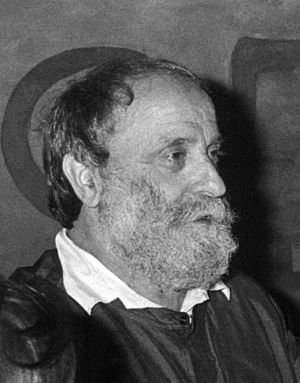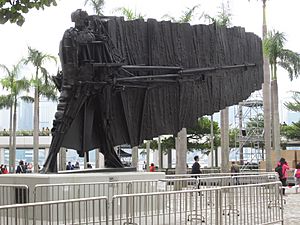César Baldaccini facts for kids
Quick facts for kids
César Baldaccini
|
|
|---|---|
 |
|
| Born |
Cesare Baldaccini
1 January 1921 Marseille, France
|
| Died | 6 December 1998 (aged 77) Paris, France
|
| Known for | Sculpting |


César (born Cesare Baldaccini; January 1, 1921 – December 6, 1998) was a famous French sculptor. He was known for his unique and sometimes surprising artworks.
César was a leader in the Nouveau Réalisme art movement. He created art by compressing (squishing) things like cars and metal. He also made huge sculptures from foam and fun shapes of animals.
Contents
César Baldaccini: A Sculptor's Story
Early Life and Art Beginnings
César was born in 1921 in Marseille, France. His parents were from Tuscany, Italy. His father worked as a barrel maker and owned a bar.
César studied art at the Ecole des Beaux-Arts in Marseilles from 1935 to 1939. Later, he continued his studies at the Ecole des Beaux-Arts in Paris from 1943 to 1948. His first art show was in Paris in 1954.
Crushing Ideas: The Compressions
In his early career, César made sculptures from welded metal and junk materials. By 1960, he was a leading sculptor in France. That year, he visited a scrap yard. He saw a machine that crushed metal. This gave him a new idea for his art.
He decided to use the crushing machine in his sculptures. He shocked people by showing three crushed cars at a Paris art show. These "Compressions" made him very famous. César carefully chose which cars to crush. He even mixed parts from different colored cars. This allowed him to control the look and colors of his art.
Later in 1960, he joined a group called the Nouveaux Réalistes (New Realists). This group included artists like Arman and Pierre Restany. They found their art ideas in everyday city life.
New Materials and Big Art
In 1965, César started working with plastics. He first made plastic molds of human shapes. Then, from 1966, he poured liquid polyurethane foam. This foam would expand and become solid. He stopped making welded metal sculptures in 1966.
From 1967 to 1970, he held public events called "Happenings." During these events, he created his foam "expansions" in front of an audience. His later works also included sculptures made from melted crystal.
In 1995, César was asked to paint a special race car. It was a McLaren F1 GTR that raced in the famous 24 Hours of Le Mans event. This car still has César's unique design. It is the only "Art Car" based on the McLaren.
Famous Works and Awards
César also designed the trophy for the César du cinéma. This award is given to the best in French movies.
He received a high honor in France called the Légion d'honneur. He was made a Knight in 1978 and an Officer in 1993.
César was married to Rosine and they had one daughter. He passed away in Paris in December 1998.
Where to See His Art
You can see César's artworks in many places. Some are in the permanent collection of the Centre national d'art et de culture Georges-Pompidou in Paris. These include Bas relief, Tortue, and le Diable.
The Musée d'art moderne de la Ville de Paris has his Facel Véga. He also designed his own grave at the Montparnasse Cemetery.
Other famous works include Le Pouce (The Thumb) on the esplanade de La Défense in Paris. A giant version, Le Pouce Géant, is in Marseille.
One of his well-known pieces, Conserve expansion - Martial Raysse (1970-1972), is at the Museo Cantonale d'Arte in Lugano. His sculpture The Flying Frenchman was placed in Hong Kong in the early 1990s.
See also
 In Spanish: César Baldaccini para niños
In Spanish: César Baldaccini para niños



